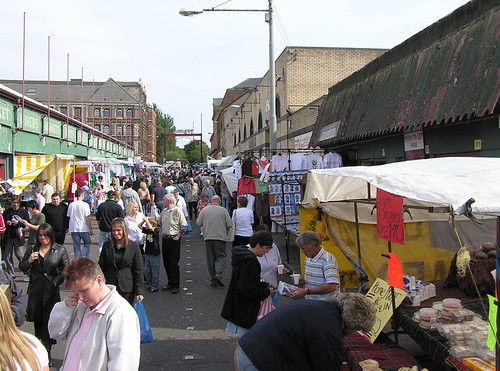The Barras

Glasgow's famous East End market with over 1000 traders flogging their wares. Worth coming if only to hear their patter.
Trongate is said to be one of the oldest streets in the city of Glasgow. Trongate begins at Glasgow Cross and becomes Argyle Street as you head westwards. The street owes its name to the weighbeam which was erected here in the 16th century. The Tron church which dates back to the 17th century is the best known landmark in the street, redeveloped into a theatre in the 1980s.
Just south of Trongate, around King St, is a lively area crammed with contemporary art galleries and studios.
Many of the works are for sale so it's a good hunting ground for original gifts
The Merchant City is bounded to the east by the High Street and to the south by Trongate. These two streets meet at Glasgow Cross, once the centre of trade and administration and regarded as the city centre, until the coming of the railway in the mid-19th century.
In the centre of the intersection stands the 126 ft-high Tolbooth Steeple, one of only three crowned steeples in the country. This is the only remnant of the original tolbooth built in 1626, which housed the courthouse and prison (described by Sir Walter Scott in Rob Roy).
The Mercat Cross next to the steeple is a 1929 replica of the medieval original.
The nearby Tron Steeple is the only surviving part of St Mary's Church, built in 1637. This church was accidentally burned down by drunken members of the aptly-named Glasgow Hellfire Club in 1793.
After a meeting, they went to the church to warm themselves by a fire, which they built up until it got out of control. The steeple has been incorporated into the modern frontage of the Tron Theatre and the interior of the replacement church forms the theatre auditorium.
Nearby, at 14 King Street, is the Sharmanka Kinetic Gallery and Theatre, which puts on performances by mechanical sculptures made from carved wooden figures and old bits of junk. A great place to take the kids.
Performances on Sun at 1500 (short programme for children) and 1800, Tue 1300, Thu 1900. £3 (£2 children). (Tel: 5527080), www.sharmanka.co.uk
To the south, on Bridgegate, is the Merchants' Steeple, built as part of the Fishmarket in 1872. The 164 feet-high steeple, with details in Gothic and Renaissance style, is all that's left of the old Merchants' House, built in 1651-59.
South of The Barras is the wide expanse of Glasgow Green, said to be the oldest public park in Britain.
It has been common land since at least medieval times and Glaswegians still have the right to dry their washing here.
Bonnie Prince Charlie reviewed his troops here in 1745 before they were hung out to dry by the English at Culloden.
The Green has always been dear to the people of Glasgow and some of the city's major political demonstrators have held meetings here, including the Chartists in the 1830s and Scottish republican campaigners in the 1920s.
There are various monuments dotted around the park, including a 144 feet-high monument to Lord Nelson, erected in 1806, and one to James Watt.
Just to the north of the Green are two of the city's oldest churches, dating from the mid-18th century.
In St Andrew's Square is St Andrew's Church, and nearby is the episcopal St Andrew's-by-the-Green, once known as the Whistlin' Kirk because of the introduction of its organ, a radical move in those days.
On the edge of the green, to the east of the People's Palace (see below), is Templeton's Carpet Factory, a bizarre structure designed in 1889 by William Leiper in imitation of the Doge's Palace in Venice.
It's Britain's best example of polychromatic decoration (in other words, very colourful). The building is now used as a business centre.
On the northern end of the green, approached from London Road, is the People's Palace, opened in 1898 as a folk museum for the East End.
The recently refurbished museum gives a real insight into the social and industrial life of this great city from the mid-18th century to the present day.
Its galleries display a wealth of artefacts, photographs, cartoons and drawings, and a series of films, music and people's anecdotes.
A visit to the People's Palace should be on everyone's itinerary, particularly if you're interested in scratching beneath the city's surface and getting to know it better.
Equally recommended is the Winter Gardens, a huge conservatory at the rear of the museum, where you can enjoy a cup of tea or coffee in tropical surroundings.
Mon-Thu and Sat 1000-1700, Fri and Sun 1100-1700. Free. (Tel: 5540223).

Glasgow's famous East End market with over 1000 traders flogging their wares. Worth coming if only to hear their patter.

Somewhat bizarre structure designed in 1889 by William Leiper in imitation of the Doge's Palace in Venice. It's Britain's best example of polychromatic decoration (in other words, very colourful). The building is now used as a business centre.
Guide To Scotland | Aberdeenshire | Cairngorms | North Highlands | Ayrshire | Argyll | Inner Hebrides | Skye | East Lothian | Scottish Borders | Dumfries & Galloway | Fife | Perthshire | Outer Hebrides | Edinburgh | Scottish Castles | Stag Weekends | Hen Nights
Privacy | Terms | Find out about advertising on site | About HelpMeGo.To